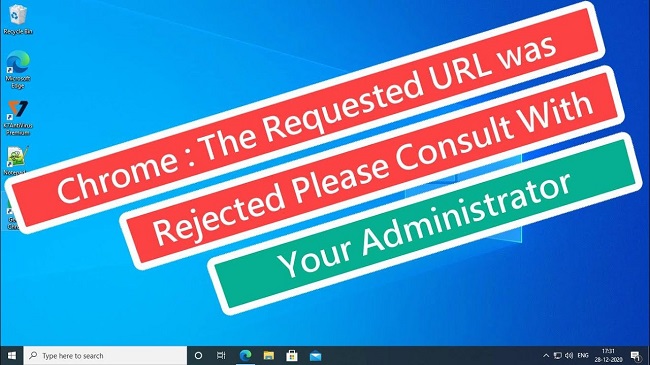A Refusal of the URL You Requested Has Occurred. An error message reading “Please Consult With Your Administrator” may display in your browser window if you try to access a blocked website. The issue can show up on any website, even those that promise to be secure.
Contents
Method 1: Empty the Browser’s Cache and Remove All Cookies
The first option is the most practical, as many people have experienced success after just emptying their browser’s cache and cookies. Errors like this can be avoided by periodically clearing browsing data, which can collect quickly.

Google Chrome:
Step 1: To delete all Google Chrome history, use the menu button (three vertical dots) located in the upper-right corner of the browser. Next, select Clear browsing data from the Additional Tools menu.
Step 2: For a complete reset, pick “From the Beginning of Time” as the time range and delete everything from there. It’s suggested that you delete your browser’s temporary files and cookies.
Step 3: Try restarting your computer and opening Google Chrome to see if the problem persists.
Mozilla Firefox:
Step 1: Double-click the Firefox shortcut on your desktop, or look for it in the list of programmes under the Start menu, to launch Mozilla Firefox.
Step 2: To access your browser’s browsing history, select the library icon (to the left of the menu button) in the upper right corner of the window. Distinct Recent Past…
Step 3: You now have a large number of choices to make. Choose “Everything” from the drop-down menu that appears when you click the arrow next to the Time range to clear option.
Step 4: Since “Clear history” may not imply the same thing as it does in other browsers and may include all sorts of surfing data, you can check exactly what will be deleted by clicking the arrow next to Details.
Step 5: Select Cookies before you hit Clear Now, please. Hold off until it’s done, and then launch your browser again. Verify if the issue persists or if it has been resolved.
A Word About Microsoft’s New Web Browser, Edge
Step 1: Either click the Edge app’s taskbar icon or type ‘Edge‘ into the Start menu search box to launch Microsoft’s latest web browser.
Step 2: Once the browser has opened, select Settings by clicking the three vertical dots in the upper right corner.
Step 3: Select What to Clear under the heading Clear Browsing Data.
Step 4: Don’t uncheck the fifth option until you’ve reviewed the previous four. Verify if you see the error message “The Requested URL Was Denied.” The “This Error Has Been Reported To Your Administrator And Will Not Go Away” message still appears!
Method 2: Include The Offending URL in Your List of Trusted Sites
When only one website causes problems, and you are confident in the site’s safety, you can bypass some security checks by adding it to Internet Options in Control Panel. To accomplish this, please refer to the steps outlined below.
Step 1: Launch Internet Explorer by looking for it in the computer’s Start menu or on the desktop. There’s a settings cog in the upper right corner; click it. If you want to change how your Internet connection is established, select Internet Options from the menu that appears.
Step 2: To launch Control Panel without Internet Explorer, either search for it in the Start menu or press the Windows key plus R to bring up the Run dialogue box, then type “exe” and click OK.
Step 3: Access this section of Control Panel by clicking the Network and Internet icon and changing the view to Category from the menu at the upper right of the window. Internet Options can be accessed in the same way as in Internet Explorer by clicking the Tools menu in the top-right corner of this window.
Step 4: Go to Settings > Security > Trusted Sites. In the Add URL field, type the URL of the problematic website and click the Add button. Ensure that you are only supplying the relevant URL.
Step 5: After adding the site, go to the Websites section and uncheck the box labelled “Require server verification option (https) for all sites in this zone.”
Step 6: Close Internet Options, restart the browser in which you encountered the error, and verify if you still get the same message when you try to load the page in question.






























